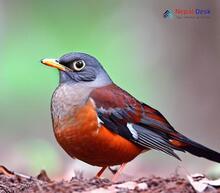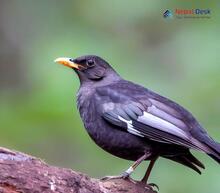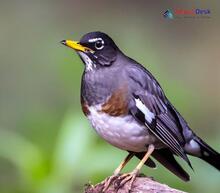Nepal, a country nestled between the majestic peaks of the Himalayas and verdant valleys, boasts a remarkable diversity of plant and animal life. Among the countless species that inhabit this breathtaking nation is the enthralling bird genus Turdus. With their distinctive features and intriguing behavior, these birds have piqued the interest of birdwatchers and nature lovers alike. Here, we will present an in-depth profile of this exceptional bird genus found in Nepal.
A Deeper Dive into the Turdus Genus
Turdus belongs to the family Turdidae and is a genus of birds frequently referred to as thrushes. Comprised of over 65 species, they can be found in diverse habitats such as forests, grasslands, and suburban areas. While some species are renowned for their melodious songs, others are distinguished by their eye-catching coloration.
Distribution and Habitat Across Nepal
Various Turdus species can be observed in different areas throughout Nepal, spanning various elevations. Ranging from subtropical lowlands to temperate forests at higher altitudes, these adaptable birds have left their mark across the nation. Some notable species living in Nepal include the Black-throated Thrush (Turdus atrogularis), Grey-winged Blackbird (Turdus boulboul), and Red-throated Thrush (Turdus ruficollis).
Physical Features
Typically, Turdus birds have a stout body complemented by rounded wings and a robust beak suited for consuming diverse food sources like insects or fruits. The size of these birds varies from small to medium depending on the species but generally falls within the range of 20-30 cm in length. The colors of their plumage also vary significantly - some exhibit glossy black feathers with contrasting white patches while others showcase vibrant hues of orange, red, or blue.
Feeding Habits
Invertebrates such as worms, snails, insects, and spiders predominantly make up the diet of Turdus birds. However, they are also known to eat an assortment of fruits and berries based on seasonal availability. They typically forage either on the ground or high up in trees while nimbly hopping around to find food. Their mighty beaks come in handy when cracking open snail shells or unearthing insects hidden in leaf litter.
Breeding and Nesting Patterns
Turdus birds exhibit monogamous breeding behavior, as mating pairs collaborate to construct nests, incubate eggs, and rear their offspring. Nests are often built within trees or shrubs using materials like grass, mud, leaves, and twigs. The inconspicuous nests provide excellent camouflage and a secure environment for raising chicks.
Conservation Status
Though many Turdus species have extensive distribution ranges and stable populations, some are deemed vulnerable or endangered due to habitat destruction and other human-related factors. As a result, establishing protected areas and promoting sustainable eco-tourism practices are crucial to ensure the long-term survival of these captivating birds.
In summary, Turdus birds native to Nepal offer a fascinating glimpse into both the country's abundant biodiversity and the mesmerizing world of avian life. For those who traverse Nepal's varied landscapes in search of one-of-a-kind wildlife encounters, spotting these charming winged inhabitants is surely a moment to treasure.




